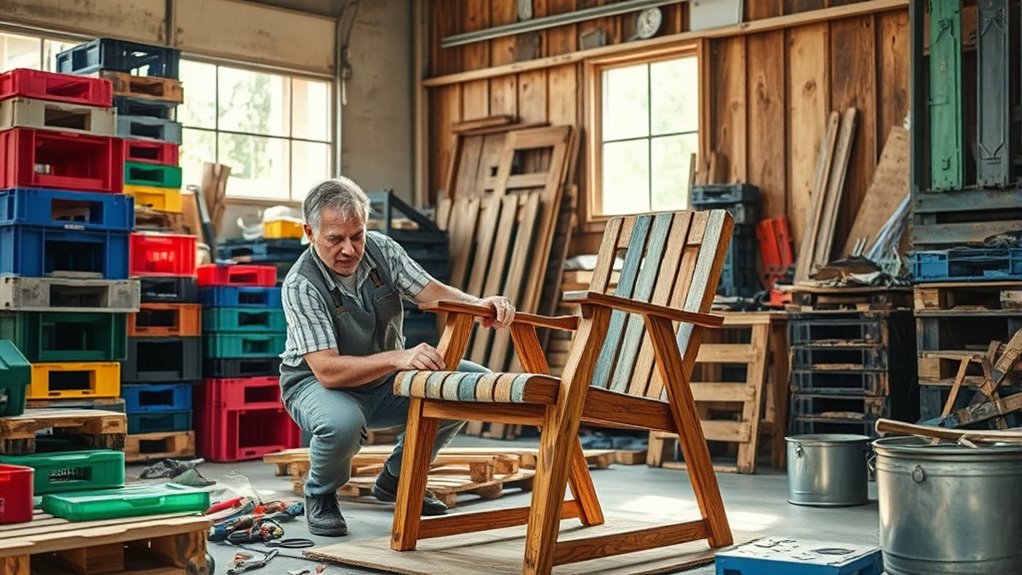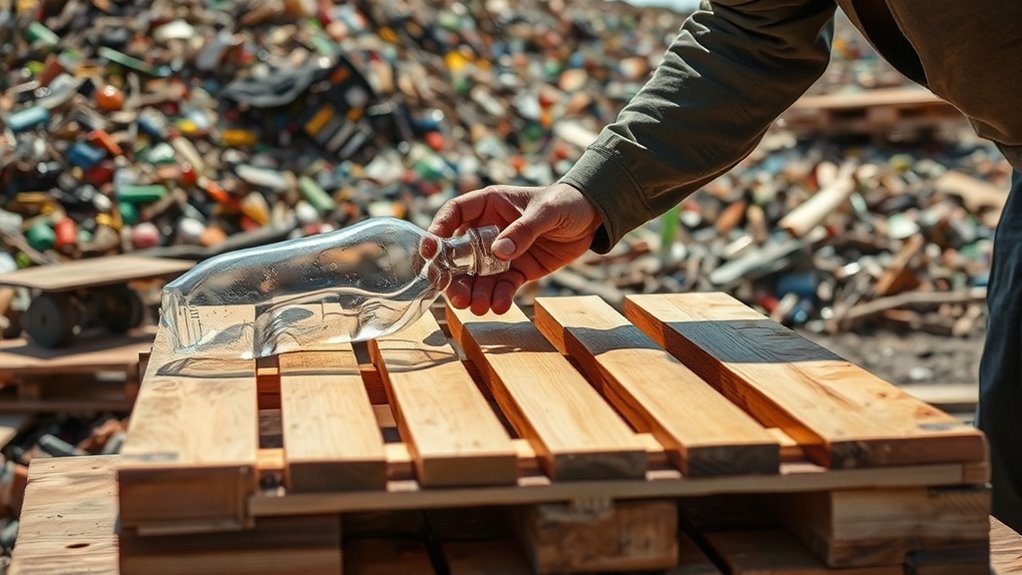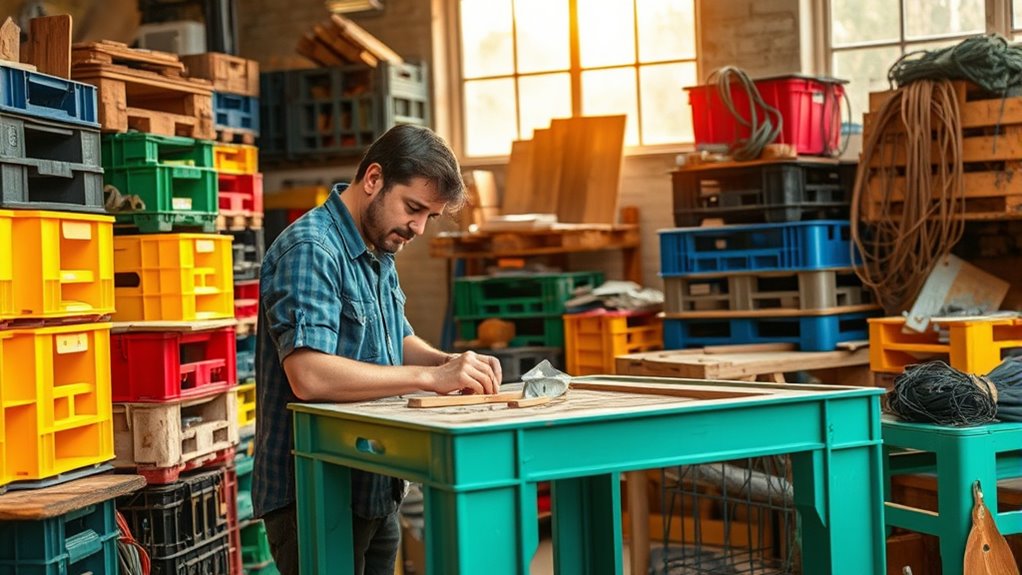Discover how individual entrepreneurs transform landfill finds into stylish, eco-friendly furniture. By repurposing discarded materials like old wood, metal, and plastics, they create unique, trendsetting pieces that challenge wastefulness. These innovators face challenges like quality concerns and logistics but make a real environmental impact by reducing waste and supporting communities. If you want to explore how such creative reuse can change the industry and inspire sustainability, there’s plenty more to uncover ahead.
Key Takeaways
- Entrepreneurs are transforming discarded landfill materials like wood, metal, and plastics into stylish, eco-friendly furniture pieces.
- Upcyclers combine textures and colors from waste to create visually appealing, trendy furniture that challenges throwaway culture.
- Innovative techniques and advanced processing enhance durability and aesthetic appeal of landfill-derived furniture.
- The movement promotes sustainability, reduces waste, and supports circular supply chains in the furniture industry.
- Community engagement and entrepreneurial efforts drive awareness and adoption of landfill-to-furniture reuse as a viable business model.
The Inspiration Behind Upcycled Creations

Many upcycled creations draw their inspiration from the urgent need to reduce furniture waste and its environmental impact. When you see a worn-out chair or an outdated table, it’s easy to toss it away. But these items can be transformed into something stylish and functional with creativity and effort. The environmental crisis caused by landfill overflow motivates entrepreneurs and artists to reimagine discarded furniture. Instead of adding to waste, they find beauty and purpose in what others see as trash. This mindset not only helps cut down on landfill contributions but also sparks innovation. By giving old furniture a second life, you contribute to a more sustainable future while creating unique, personalized pieces. Upcycling turns waste into worth, inspiring a new approach to furniture that benefits everyone. Proper storage and maintenance of materials can prolong the life of upcycled pieces and ensure their durability over time, making sustainable furniture solutions more viable. Incorporating upcycling techniques can further enhance the quality and creativity of these eco-friendly projects, and understanding furniture design principles can help maximize both form and function. Additionally, paying attention to material selection can greatly influence the longevity and aesthetic appeal of the finished piece.
Transforming Waste Into Artful Furniture

Transforming waste into artful furniture offers a powerful way to combat the mounting landfill crisis. You can take discarded materials—old wood, metal, plastics—and turn them into unique, stylish pieces. By repurposing what others see as trash, you give new life to materials that would otherwise end up in landfills. This process not only reduces waste but also creates one-of-a-kind furniture with character and history. Skilled craftspersons often combine different textures, colors, and shapes to produce visually striking designs that tell a story. This approach challenges the throwaway culture encourages sustainable consumption, and highlights creativity. When you choose upcycled furniture, you’re making an environmentally conscious statement while adding distinctive, conversation-starting pieces to your space. Additionally, incorporating upcycled materials into furniture design can enhance the durability and uniqueness of each piece. Using diverse designs and materials like recycled products can further elevate the aesthetic appeal and sustainability of upcycled furniture. Moreover, integrating beach debris like driftwood or plastic fragments can evoke natural coastal themes and promote awareness about marine pollution. Incorporating innovative techniques such as embedding reclaimed metal or glass can further showcase craftsmanship and innovation in furniture making.
Challenges in the Upcycling Industry

Despite the growing interest in upcycling, the industry faces significant hurdles that hinder widespread adoption. Quality inconsistency is a major challenge; recycled materials often vary in durability and appearance, making it difficult to meet consumer expectations. Advanced processing technologies are costly to develop and implement, limiting access for smaller entrepreneurs. Logistical issues also complicate collection and transportation, especially for large or fragile furniture pieces. Additionally, many consumers and businesses lack awareness of upcycling’s environmental and economic benefits, reducing demand. Consumer education can play a vital role in increasing understanding and appreciation for upcycled products. Furthermore, the reliability of recycled materials remains a concern, as inconsistent quality can lead to dissatisfaction and product failure. Incorporating mindfulness in the production process can help entrepreneurs focus on sustainable practices and quality control. Regulatory restrictions and safety standards can further slow growth, as recycled materials must meet strict guidelines. Overcoming these obstacles requires investment, education, and innovation, but doing so is essential to expanding the industry and making upcycled furniture a mainstream choice. Forsale 100
Environmental Impact and Community Benefits

Reusing and recycling furniture considerably reduces environmental harm by lowering greenhouse gas emissions and conserving natural resources. When you choose to repurpose landfill finds, you help prevent unnecessary waste accumulation and minimize the need for new manufacturing. This effort decreases demand for raw materials like timber, metals, and plastics, preserving ecosystems and reducing pollution. Community benefits include creating local jobs in recycling and upcycling businesses, supporting charitable organizations with donated furniture, and fostering sustainable habits. Additionally, promoting awareness of emotional support can inspire community engagement through creative and trendy naming options for pets. Incorporating mindfulness practices into upcycling projects can further enhance community involvement and personal well-being, aligning with the Law of Attraction principles to manifest positive change. Understanding Personal Finance Management can also help entrepreneurs allocate resources wisely and sustain their environmentally conscious initiatives.
Future Goals and Expanding the Movement

As awareness of the furniture waste crisis grows, the movement to reduce landfill contributions and promote sustainable practices is expanding rapidly. You can play a crucial role by supporting businesses that prioritize reuse, recycling, and eco-friendly manufacturing. Entrepreneurs are setting ambitious goals, like designing furniture meant to last longer or creating circular supply chains that keep materials in use. There’s a push to develop better recycling technologies to process complex materials efficiently. Public awareness campaigns are gaining momentum, encouraging consumers to buy secondhand or choose sustainable options. Local governments are also implementing policies to incentivize furniture reuse and recycling. Additionally, advances in AI-generated content are helping designers create innovative, eco-conscious furniture concepts more efficiently. Understanding zodiac compatibility can even inspire creative collaborations based on personality traits and shared values. Moreover, fostering community engagement can accelerate the adoption of sustainable furniture practices among consumers and local businesses. Strategies such as material innovation are essential for creating more sustainable and durable furniture options. For example, utilizing improved recycling techniques can significantly reduce waste that ends up in landfills. Together, these efforts aim to transform the industry, making sustainable furniture the norm rather than the exception, and greatly reducing landfill waste.
Frequently Asked Questions
How Do You Ensure the Safety and Durability of Upcycled Furniture?
You guarantee the safety and durability of upcycled furniture by thoroughly inspecting and cleaning each piece before use. Reinforce weak spots with quality materials, like sturdy wood or metal, and apply durable finishes to protect against wear. Use non-toxic, eco-friendly sealants and adhesives to prevent chemical leaching. Regular maintenance also helps, so you can spot and repair issues early, ensuring your furniture remains safe, strong, and long-lasting.
What Are the Most Common Materials You Repurpose From Landfills?
You repurpose wood, metal, and plastic from landfills to create furniture. You salvage aged, weathered wood for rustic tables and chairs, reuse scrap metal for sturdy frames and decorative accents, and recycle plastics into vibrant, durable surfaces. You transform these materials into stylish, eco-friendly pieces that give new life to discarded items. By doing so, you reduce waste, conserve resources, and make a positive impact on the environment while offering unique, sustainable furniture.
How Do You Source Your Waste Materials for Furniture Creation?
You source your waste materials by partnering with local businesses, waste management facilities, and recycling centers that regularly discard usable furniture and materials. You also keep an eye on donation programs and surplus inventories from corporations. Visiting landfills and junkyards to find valuable items is part of your routine. By building relationships with these sources, you guarantee a steady stream of high-quality, eco-friendly materials for your furniture projects.
What Certifications or Standards Do Your Upcycled Pieces Meet?
You should look for upcycled furniture that meets recognized certifications like FSC, Greenguard, or LEED standards. These guarantee your pieces are environmentally friendly, safe, and sustainably sourced. Check if the materials have been tested for toxins and if the manufacturing process adheres to strict environmental guidelines. By choosing certified pieces, you demonstrate your commitment to sustainability and quality, giving you confidence in the durability and eco-consciousness of your furnishings.
How Can Consumers Identify Genuinely Eco-Friendly Upcycled Furniture?
To spot genuinely eco-friendly upcycled furniture, look for labels and logos from trusted environmental organizations like FSC or Green Seal. Check for transparency—ask about the materials, manufacturing process, and recycling credentials. Seek stories of sustainability and certifications that showcase eco-conscious craftsmanship. Trust your taste and intuition, and choose pieces that emphasize ethical processes, durability, and design—delighting you while doing good for the planet.
Conclusion
You can be part of a movement that turns trash into treasure, reducing landfill waste and creating stylish furniture. Did you know that upcycling can cut waste by up to 70%? By supporting entrepreneurs like this, you help protect the environment and boost local communities. Every piece you buy makes a difference, inspiring others to see waste as a valuable resource. Join the trend and help transform landfills into vibrant hubs of creativity.








